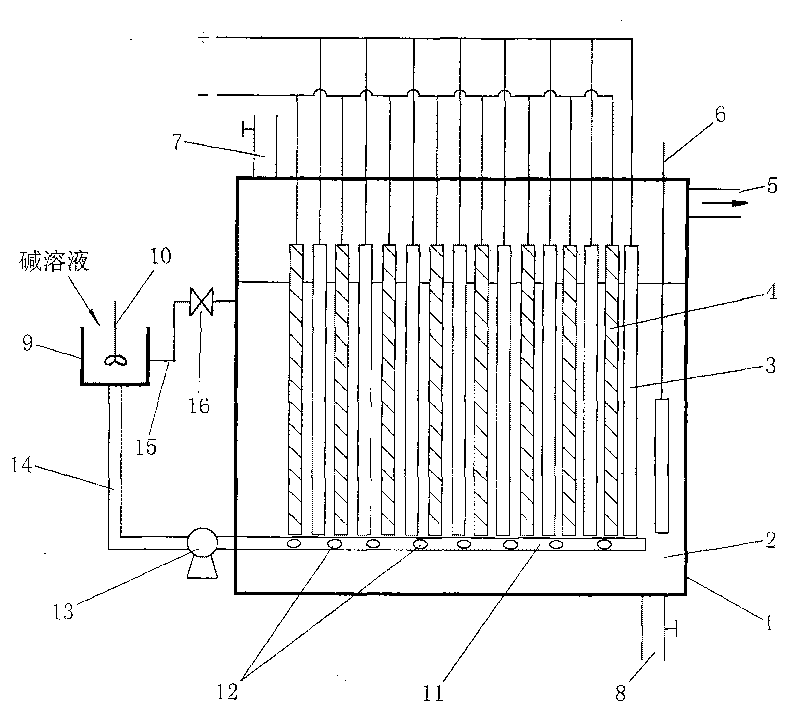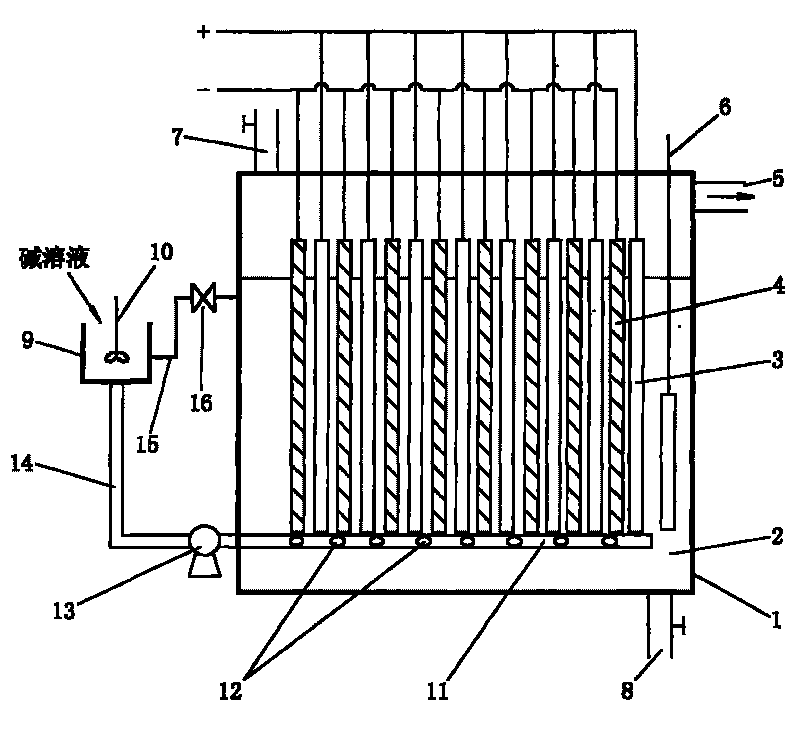Method for treating nickel-containing electroplating wastewater and recovering nickel by electrolysis
A technology for electrolytic treatment and electroplating wastewater, applied in metallurgical wastewater treatment, water/sewage treatment, chemical instruments and methods, etc., can solve the problems of difficult control, secondary pollution, low removal rate, etc., and reduce the electrolysis of hydrogen on the cathode plate The effect of side effects
- Summary
- Abstract
- Description
- Claims
- Application Information
AI Technical Summary
Problems solved by technology
Method used
Image
Examples
Embodiment 1
[0035] Refer to attached figure 1, a method for electrolytically treating nickel-containing electroplating wastewater and recovering nickel. The electrolytic treatment of nickel-containing electroplating wastewater is carried out through an electrolytic treatment device for nickel-containing electroplating wastewater. The electrolytic treatment device for nickel-containing electroplating wastewater includes an electrolytic cell 1 and an electrolyte stirring device, The electrolytic cell 1 adopts a glass electrolytic cell, the anode 3 adopts a titanium-based platinum electrode, and the cathode 4 adopts a nickel electrode. The anode 3 and the cathode 4 are arranged alternately in a unipolar parallel manner, and the top of the electrolytic cell 1 is provided with an exhaust port 5 and a feed port 7. A valve is provided on the feed port 7, a pH meter 6 is provided in the electrolytic cell 1, a discharge port 8 is provided at the bottom of the electrolytic cell 1, and a valve is pro...
Embodiment 2
[0038] Refer to attached figure 1 , The electrolytic treatment device for electrolytic treatment of nickel-containing electroplating wastewater is the same as in Example 1.
[0039] The method for electrolytic treatment of nickel-containing electroplating wastewater is: the electroplating wastewater with a nickel concentration of 100.0 mg / L enters the electrolytic cell 1 through the feed port 7 as the electrolyte 2, and an appropriate amount of Ca(OH) is added to the electrolyte 2 2 The solution adjusts the pH value of the electroplating wastewater to 6.5, and the distance between the anode 3 and the cathode 4 is 20mm; during electrolysis, 10V direct current is passed, and Ca(OH) 2 Add the solution into the pH adjustment tank 9 of the electrolyte stirring device, and slowly add 0.1mol / L Ca(OH) under the anode 3 through the outlet hole 12 on the infusion tube 11 of the electrolyte stirring device 2 The solution makes the pH value of the electroplating wastewater reach 6.9, and...
Embodiment 3
[0041] Refer to attached figure 1 , The electrolytic treatment device for electrolytic treatment of nickel-containing electroplating wastewater is basically the same as Example 1, wherein the cathode 4 uses a graphite electrode. The method for electrolytic treatment of nickel-containing electroplating wastewater is: the electroplating wastewater with a nickel concentration of 100.0 mg / L enters the electrolytic cell 1 through the feed port 7 as the electrolyte 2, and an appropriate amount of NaOH solution is added to the electrolyte 2 to reduce the electroplating wastewater. The pH value is adjusted to 6.9, and the distance between the anode 3 and the cathode 4 is 15mm; during electrolysis, 8V direct current is applied, and the NaOH solution is added to the pH adjustment tank 9 of the electrolyte stirring device, and the infusion tube 11 of the electrolyte stirring device is passed The liquid outlet hole 12, slowly add 1mol / L NaOH solution under the anode 3 to make the pH value...
PUM
 Login to View More
Login to View More Abstract
Description
Claims
Application Information
 Login to View More
Login to View More - R&D Engineer
- R&D Manager
- IP Professional
- Industry Leading Data Capabilities
- Powerful AI technology
- Patent DNA Extraction
Browse by: Latest US Patents, China's latest patents, Technical Efficacy Thesaurus, Application Domain, Technology Topic, Popular Technical Reports.
© 2024 PatSnap. All rights reserved.Legal|Privacy policy|Modern Slavery Act Transparency Statement|Sitemap|About US| Contact US: help@patsnap.com









